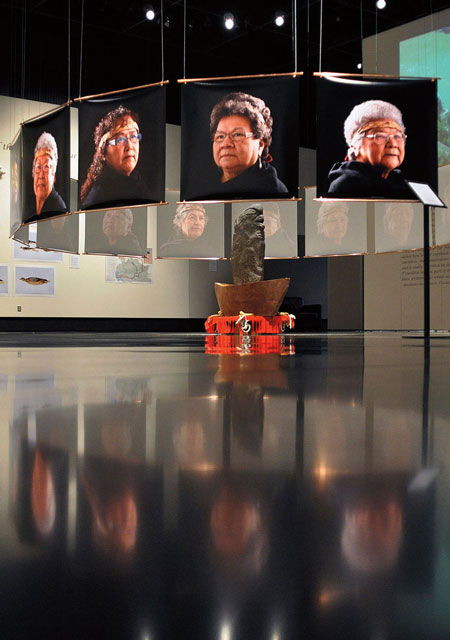![]()
![]()
Stó:lō Nation / Stó:lō Research
& Resource Management Centre

The Reach Gallery
Museum Abbotsford

Afterword
Experiments in Visual Art, Alternative History, and Community Collaboration
Scott Marsden,
Curator, The Reach Gallery Museum Abbotsford
This essay explores how the exhibition Man Turned to Stone: T'xwelátse recontextualized contemporary visual art, history, and community collaboration as a process of creative inquiry. Through the exhibition, The Reach Gallery Museum Abbotsford was transformed into a public space that stimulated social interaction, dialogue, debate, and exploration of community issues relevant to the people of the Fraser Valley, in southwestern British Columbia. The exhibition informed visitors about the practices and traditions of the Stó:lō people. It helped to articulate the mission of T'xwelátse as a living teaching icon who carries the message that we must learn to live together in a good way. His message contains stories that are valuable educational tools for contemporary society.
Alternative historical narratives
The Man Turned to Stone: T'xwelátse exhibition offered an alternative version of the history of the Fraser Valley, in which a dominant social hierarchy is both questioned and subverted. It offered another way of seeing and understanding different belief systems, in which the past and the present are both presented and re-presented. Man Turned to Stone: T'xwelátse was a catalyst for dialogue between communities with a focus on both specific historical and contemporary contexts. It gave expression to both human agency and life experiences in and around specific social and cultural changes over time.
The exhibition challenged visitors' understanding of a dominant version of history and encouraged multiple narratives and representations that reflect everyone in the community. It did this partly by presenting a story from the past juxtaposed with the dominant historical narrative of white settler culture. In doing so, it provided for gallery visitors an example of what the Russian literary theorist Mikhail Bakhtin calls "words of others." The voices of others, their discourse, are central to Bakhtin's theory of how people develop their ideologies. He posits that we learn and grow as we interact with and assimilate into our consciousness the voices of those who surround us.
The "words of others," by revealing other potential meanings and the ideology behind the dominant discourse, make possible a space for new interpretations, and change becomes possible. Bakhtin (1981) argued that "dialogical" discourse—any cultural expression built on multiple, even conflicting voices in conversation with each other—can reveal deeper social truths and contradictions precisely because it rejects a single, absolute authoritative voice. For Bakhtin, dialogue comes out of a mixing of many social voices, ideas, and worldviews.
Community collaboration in action
Recent developments in current contemporary curatorial practice explore the idea of community collaboration, particularly in the formation of community advisory groups that work at various levels of gallery operations. The Reach Gallery Museum Abbotsford, the T'xwelátse family, and the Stó:lō Research and Resource Management Centre agreed on a collaborative approach in the development of Man Turned to Stone: T'xwelátse. The curatorial work in this exhibition was an attempt to mediate between the gallery, the T'xwelátse family, the Stó:lō community, and the larger non-Native community. The exhibition was about weaving together stories, using subjective narratives to enable other voices to have a prominent place in what art galleries communicate.
All of the key exhibition elements were developed in collaboration with Stó:lō community leaders and Elders and the T'xwelátse family. Their consensus is that the exhibition elements were not only appropriate but also innovative and an exciting development in terms of telling the T'xwelátse story and relating it to the larger context. The Stó:lō community leaders and Elders who helped to develop this exhibition are widely respected and have long experience sharing cultural perspectives both within the Stó:lō community and with non-Aboriginal audiences.
Man Turned to Stone: T'xwelátse explored historical, cultural, and spiritual elements of the T'xwelátse transformation narrative to reveal the fundamental Stó:lō relationship to land and resources, and to begin a dialogue about the Stó:lō worldview. The exhibition offered a unique opportunity to invite the kind of participation and dialogue through which First Nation and non-Native communities can engage in the ongoing construction of social meaning. This exhibition mediates between the history, codes, and culture of the Stó:lō Nation and their neighbours, between Campion's photographs and the gallery space, and between the visitors and the exhibition. Man Turned to Stone: T'xwelátse shows that a range of practices is possible, that a language of possibilities can be explored, that different groups can be involved in pushing against the bounds of dominant cultural practices.
For the Stó:lō, Stone T'xwelátse is a spiritual being who contains the living spirit of the human being T'xwelátse, their beloved ancestor. As a sign of respect for Stó:lō protocols, Stone T'xwelátse was addressed as "he" and also covered by a specially made "coat" each night of the exhibition. Stone T'xwelátse, a transformed being, depicts the work and teachings of beings called the Transformers. The stone statue is an ancestor of the Stó:lō—a man named T'xwelátse who was born thousands of years ago.
As punishment for mistreating his wife, T'xwelátse was transformed into a four-foot-high granite statue. His wife was given the responsibility for his care, and for generations the women of the family looked after an ancestor who was a lesson inscribed in stone about how to live and act properly. The responsibility of caring for T'xwelátse was passed on to daughters or granddaughters of the T'xwelátse family, who became the caretakers for that generation.
In the exhibition, Stone T'xwelátse is surrounded by portraits of the women who are the current caretakers. As descendants of T'xwelátse and as members of the T'xwelátse family, they have inherited the responsibility of looking after their ancestor from their mothers and grandmothers before them. As part of the cultural narrative articulating T'xwelátse, photographer David Campion reflected on the physical and imaginative transformations wrought on the landscape by the shared history of colonization. The story of the repatriation that brought T'xwelátse home was reconstructed in a text-based installation that incorporated photographs, a handwritten narrative, reports, and correspondence.
The exhibition also presented a film of the landscape of the Fraser Valley with its many transformation sites, Written in Stone. The Stó:lō traditional dance group Semoya, in a work called The Sxwōxwiyam of T'xwelátse that was projected as part of the exhibition, interpreted the birth and transformation of T'xwelátse through dance—where and how the Transformers encountered T'xwelátse and turned him to stone.
Art process as dialogue
Work by photo-based artist David Campion was an integral part of this exhibition, demonstrating how visual art can be a critical form of creative inquiry. Campion utilized his own visual vocabulary in a form of engaged social documentary to weave together multiple transformation narratives focused around T'xwelátse from the recent era of colonization by white settlers looking for land and resources.
The art practice of Campion involves a type of social engagement where the artist collaborates with the Stó:lō community. He asks provocative questions concerning the role of the artist, their relationship with the subject, and the demands of the audience. Central to this process is the exploration of the concept of dialogue as a form of engaged visual art practice.
Campion's photo-narratives recontextualized the landscape and were meant to document not so much the Stó:lō as the forces that created the conditions in which they now work and live. Campion sees the power of communication resulting from a process of production. His work explores the different kinds of collaboration that exist between the photographer and photographed, to ensure that the person behind the camera is not appropriating the identity of the person in front of the lens. Campion's art practice is situated within vernacular photography and the development of realism as a photographic practice.
In the realist photographic tradition, each photograph is related to a specific cultural experience and how the photographer at a particular moment frames a subject. Campion's photographic works for this exhibition further the exploration and development of realism by utilizing the power of photography to reshape stereotypes of the Stó:lō community. They help to create a retelling of the Stó:lō worldview, offering the viewer other ways of seeing.
Man Turned to Stone: T'xwelátse provided the most comprehensive account yet assembled of the significant historical, cultural, and spiritual elements of the story of T'xwelátse and presented a core understanding of the Stó:lō people. The exhibition offered the unique challenge of how to present Stone T'xwelátse, the embodiment of a living being, containing the soul of T'xwelátse, a shxwlá:m or "Indian doctor" who was transformed to stone. This exhibition provided Stó:lō Nation with an opportunity to share private memories and stories and reveal other versions of history with the intention of community building through a dialogue in the form of an exhibition.
The contested gallery space
Art galleries are often seen as contested public spaces where social hierarchies are questioned and subverted, marked by the expression of a range of different convictions and beliefs, in which the past and the present are both represented. Art galleries are sites where dominant discourses can be critiqued by juxtaposing them with competing voices and exhibiting diverse points of view. The concept of conflicting voices and assimilation of the "words of others," and conscious and unconscious thoughts, can situate art galleries as sites to explore how through visual art possibilities exist to resist the dominance of a single monologist perspective, allowing numerous points of view and systems of belief to be articulated in the form of exhibitions.
Man Turned to Stone: T'xwelátse provided The Reach Gallery Museum Abbotsford an opportunity to function as a "contact zone" and space for dialogue between different identities, people, artworks, and living beings such as T'xwelátse. This exhibition was meant to provoke a dialogue with the viewer in an attempt to understand the form, theme, and context of each artwork and help make connections with the photographs that tell the story of T'xwelátse, Man Turned to Stone.
By presenting Man Turned to Stone: T'xwelátse, The Reach temporarily became a space for dialogue in the sharing of stories and multiple versions of history. Hooper-Greenhill (1994) asserts "that the role of the museum in the process of meaning-making entails understanding the museum as a site for negotiating cultural borderlands and a space to create contact zones where different identities, people, art works and artefacts can discover new possibilities to develop a cultural re-mapping, to re-write cultural borders and empower the museum visitor" (Hooper-Greenhill, 1994, pp. 12–13).
Man Turned to Stone: T'xwelátse was a catalyst for dialogue between communities with a focus on both specific historical and contemporary contexts. It enabled an expression of both human agency and life experiences in and around specific social and cultural changes over time. This exhibition helped to reconstitute the function and purpose of the gallery as an open space to stimulate active and collaborative social interaction, dialogue, debate, and exploration of contemporary issues.
As public spaces, art galleries can facilitate the sharing of individual memories and stories—multiple versions of history offered in the public sphere with the intent of building community. Carol Duncan (1995) writes, "[T]o control a museum means precisely to control the representation of a community and its highest values and truth" (p. 8). Duncan goes on to say, "[E]xhibitions in art museums do not of themselves change the world.… But, as a form of public space, they constitute an arena in which a community may test, examine, and imaginatively live both older truths and possibilities for new ones."
Within Bakhtin's concept of dialogical discourse that consists of multiple and conflicting voices and can reveal diverse ways of seeing, galleries have the potential to become community spaces for sharing private memories and stories. Bakhtin further views dialogue as a process of personal transformation. By engaging in a conversation through what we see in the museum, we can enter into a subjective dialogue and exchange and examine how we can connect with others and create community. Learning in a museum is a process of making meaning and drawing connections, creating storylines based on who we are and on the world around us as part of a transformational process.
The role of The Reach in the process of meaning-making entails understanding the gallery as a site to create contact zones where different identities, people, and artworks can discover new possibilities to develop a cultural remapping, to rewrite cultural borders, and to create experiments in visual art, history, and community collaboration.
Man Turned to Stone: T'xwelátse offered access into the cultural heritage of the Stó:lō—from the events that led to the loss of Stone T'xwelátse to his subsequent recovery by the Stó:lō and the message he has to share with the community at large. That message—that we must all learn to live together in a good way—is relevant today as we attempt to bridge intercultural divides and unite communities.
In a world where negotiating the difficulties posed by profound individual and cultural differences is critical to civil society, the exhibition Man Turned to Stone: T'xwelátse offered an opportunity for people to explore their own identities in relation to others, to reflect on how people are different and how they are the same.
